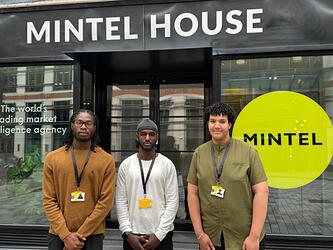We need to make space for new forms of listening

According to recent data from the Food Standards Agency, a large majority of UK shoppers say they’re concerned about ultra-processed foods (Consumer Insights Tracker, Dec ‘24).
Now, just imagine for a moment a packed single-decker bus ( 40 or 50 people). According to the survey, almost everyone on board should be quietly worrying about emulsifiers, stabilisers, and added preservatives.
Does that match what we see in real life? Are we overhearing conversations about ultra-processed foods (UPFs) on the train? Seeing passionate debates about food additives on TikTok? Not really.
In fact, when we recently analysed health food conversations across social platforms, UPFs didn’t even break the top 100 trending topics. They’re not dominating the discourse, and in many cases, they’re not mentioned at all.
That gap – between what people say in surveys and what shows up in real-world conversations – isn’t a glitch. It’s the norm. In a culture increasingly shaped by what people notice, talk about, and share, it’s a gap we can’t afford to ignore. This is where the say–do gap shows up, clearly and repeatedly.
People say they’re concerned – and when asked directly, they probably are. But that concern doesn’t always show up in what they post, talk about, or act on.
We’re not questioning the survey itself. The methodology is sound, but answering a survey isn’t the same as making a shopping decision or choosing what to talk about over coffee.
When health, ethics, or social responsibility are involved, people tend to give answers that feel right. We all do it. What we say and what we do (and even more subtly, what we notice) aren’t always aligned. That’s not a problem with the respondent. It’s a limitation of the format.
This is where social data comes in, not to replace survey research, but to validate what it tells us against real-world behaviour.
Surveys show what people say when prompted. Social shows what people talk about when no one’s asking. It captures the ideas that break through into everyday life, the things people post about, debate, joke about or quietly absorb.
It can offer:
- Spontaneity: unfiltered, in-the-moment responses
- Emotion: not just opinions, but how people feel
- Cultural context: what’s shaping attention and attitudes
- Immediacy: what’s rising, fading, and starting to stick.
It can also help sense-check things that feel slightly off. We’ve all seen those survey stats that make you pause and ask, is that really what’s going on out there? Social data gives us a way to test that instinct with a different kind of evidence.
Shaping behaviour
It’s not just researchers noticing this shift. Marketers are rethinking how they understand and influence consumer behaviour.
Unilever recently announced that it will increase its investment in social media to 50% of its global media spend, with a major shift toward influencer-led content. New CEO Fernando Fernandez has pointed to growing consumer scepticism of corporate branding and the rising effectiveness of influencers in reaching audiences with more authenticity and relevance. It reflects a broader recognition that the dynamics of attention, trust, and influence are increasingly being shaped within social platforms.
Meanwhile, a recent Lidl product launch tells a similar story. The retailer introduced a Dubai-style chocolate bar that first gained popularity through TikTok creators. It’s now stocked in stores and available through Lidl’s own TikTok shop. A viral trend turned into a product line and a new channel for social commerce.
These examples highlight a deeper shift. Social platforms aren’t just places where behaviour is reflected, they’re where behaviour is shaped. In that environment, the ability to observe, interpret and respond to social signals becomes a source of strategic advantage.
So, what’s our role in all this?
As researchers, our job is to look at the full picture – not just what people say in response to structured questions, but what they reveal through their spontaneous reactions, cultural reference points and unfiltered behaviour.
I don’t mean abandoning traditional research, but we do need to rethink how we combine it – how we layer survey insight with social signals and how we use one to test, contextualise, or challenge the other.
It’s about expanding our lens – making space for new forms of listening. It’s also about recognising that in a world shaped by fast-moving culture, unprompted data is more than noise, it’s a vital piece of the truth.
Jeremy Hollow is founder and chief executive at Listen + Learn Research

We hope you enjoyed this article.
Research Live is published by MRS.
The Market Research Society (MRS) exists to promote and protect the research sector, showcasing how research delivers impact for businesses and government.
Members of MRS enjoy many benefits including tailoured policy guidance, discounts on training and conferences, and access to member-only content.
For example, there's an archive of winning case studies from over a decade of MRS Awards.
Find out more about the benefits of joining MRS here.













1 Comment
Clive Boddy
5 months ago
Yes, ethnographic approaches are good at examining this sort of thing, as you infer. However, even without an ethnographic approach surely no professional researcher would research attitudes towards ultra-processed foods by starting with questions directly asking about ultra-processed foods? If at all, it would be the last question to be asked.
Like Reply Report